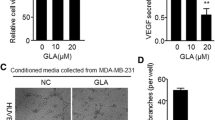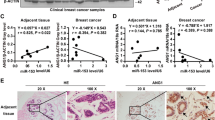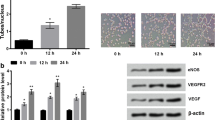Abstract
Angiogenesis is a new vessel formation process that plays a role in various physiological and pathological conditions. This process is controlled by the balance between pro-angiogenic and anti-angiogenic mediators in the organism. Angiogenesis is needed for the growth and metastasis of solid tumors. Therefore, the anti-angiogenic treatment approach is seen as an interesting option in cancers. Fenretinide, a synthetic retinoic acid analog, is an effective agent on angiogenesis. In this study, we aimed to investigate the effects of the fenretinide on some miRNAs involving in angiogenesis process and on the expression of CDH5, FOXM1 and eNOS genes upregulated in angiogenesis. In addition, it was shown the effects of this agent on cell proliferation, cell migration and capillary-like tube formation. In our study, the data were analyzed using Kruskal–Wallis and Dunn’s test. Fenretinide applied to the cells for 24 and 48 h periods reduced cell proliferation (P < 0.001) and cell migration, and suppressed tube formation (P < 0.001) as a dose dependent manner. Endothelial cells were cultured in growth-inducing media containing a variety of growth factors such as VEGF, FGF, IGF and EGF. As a result of simultaneous PCR analysis, we found that angiogenesis-promoting miR-10b was effectively suppressed (P < 0.001) and interestingly angiogenesis-modulating miR-126 was slightly increased (P < 0.05), but other miRNAs, including miR-31, miR-21, miR-101, miR-340, miR-29c, miR-206 and miR-146a were not affected. Besides, a significant decrease was observed in the levels of some angiogenesis-inducing genes, CDH5 (P < 0.001), FOXM1 (P < 0.001) and eNOS (P < 0.01 and P < 0.001) in endothelial cells treated with fenretinide. Our results have shown that fenretinide exhibited anti-angiogenic activity through the down-regulation of CDH5, FOXM1 and eNOS genes, and suppression of miR-10b.





Similar content being viewed by others
References
Sahin M, Sahin E, Gumuslu S (2009) Cyclooxygenase-2 in cancer and angiogenesis. Angiology 60(2):242–253. https://doi.org/10.1177/0003319708318378
Sahin M, Sahin E, Gumuslu S, Erdogan A, Gultekin M (2010) DNA methylation or histone modification status in metastasis and angiogenesis-related genes: a new hypothesis on usage of DNMT inhibitors and S-adenosylmethionine for genome stability. Cancer Metastasis Rev 29(4):655–676. https://doi.org/10.1007/s10555-010-9253-0
Bussolino F, Mantovani A, Persico G (1997) Molecular mechanisms of blood vessel formation. Trends Biochem Sci 22(7):251–256
Du J, Yang Q, Luo L, Yang D (2017) C1qr and C1qrl redundantly regulate angiogenesis in zebrafish through controlling endothelial Cdh5. Biochem Biophys Res Commun 483(1):482–487. https://doi.org/10.1016/j.bbrc.2016.12.118
Gartel AL (2010) A new target for proteasome inhibitors: FoxM1. Expert Opin Investig Drugs 19(2):235–242. https://doi.org/10.1517/13543780903563364
Park S, Sorenson CM, Sheibani N (2015) PECAM-1 isoforms, eNOS and endoglin axis in regulation of angiogenesis. Clin Sci (Lond) 129(3):217–234. https://doi.org/10.1042/CS20140714
Al Tanoury Z, Piskunov A, Rochette-Egly C (2013) Vitamin A and retinoid signaling: genomic and nongenomic effects. J Lipid Res 54(7):1761–1775. https://doi.org/10.1194/jlr.R030833
Huang P, Chandra V, Rastinejad F (2014) Retinoic acid actions through mammalian nuclear receptors. Chem Rev 114(1):233–254. https://doi.org/10.1021/cr400161b
Sogno I, Vene R, Ferrari N, De Censi A, Imperatori A, Noonan DM, Tosetti F, Albini A (2010) Angioprevention with fenretinide: targeting angiogenesis in prevention and therapeutic strategies. Crit Rev Oncol Hematol 75(1):2–14. https://doi.org/10.1016/j.critrevonc.2009.10.007
Anding AL, Jones JD, Newton MA, Curley RW Jr, Clagett-Dame M (2018) 4-HPR Is an endoplasmic reticulum stress aggravator and sensitizes breast cancer cells resistant to TRAIL/Apo2L. Anticancer Res 38(8):4403–4416. https://doi.org/10.21873/anticanres.12742
Anding AL, Chapman JS, Barnett DW, Curley RW Jr, Clagett-Dame M (2007) The unhydrolyzable fenretinide analogue 4-hydroxybenzylretinone induces the proapoptotic genes GADD153 (CHOP) and Bcl-2-binding component 3 (PUMA) and apoptosis that is caspase-dependent and independent of the retinoic acid receptor. Cancer Res 67(13):6270–6277. https://doi.org/10.1158/0008-5472.CAN-07-0727
Ferrari N, Morini M, Pfeffer U, Minghelli S, Noonan DM, Albini A (2003) Inhibition of Kaposi's sarcoma in vivo by fenretinide. Clin Cancer Res 9(16 Pt 1):6020–6029
Ferrari N, Pfeffer U, Dell'Eva R, Ambrosini C, Noonan DM, Albini A (2005) The transforming growth factor-beta family members bone morphogenetic protein-2 and macrophage inhibitory cytokine-1 as mediators of the antiangiogenic activity of N-(4-hydroxyphenyl)retinamide. Clin Cancer Res 11(12):4610–4619. https://doi.org/10.1158/1078-0432.CCR-04-2210
Samuel W, Kutty RK, Nagineni S, Vijayasarathy C, Chandraratna RA, Wiggert B (2006) N-(4-hydroxyphenyl)retinamide induces apoptosis in human retinal pigment epithelial cells: retinoic acid receptors regulate apoptosis, reactive oxygen species generation, and the expression of heme oxygenase-1 and Gadd153. J Cell Physiol 209(3):854–865. https://doi.org/10.1002/jcp.20774
O'Brien J, Hayder H, Zayed Y, Peng C (2018) Overview of MicroRNA biogenesis, mechanisms of actions, and circulation. Front Endocrinol (Lausanne) 9:402. https://doi.org/10.3389/fendo.2018.00402
Zhuang G, Wu X, Jiang Z, Kasman I, Yao J, Guan Y, Oeh J, Modrusan Z, Bais C, Sampath D, Ferrara N (2012) Tumour-secreted miR-9 promotes endothelial cell migration and angiogenesis by activating the JAK-STAT pathway. EMBO J 31(17):3513–3523. https://doi.org/10.1038/emboj.2012.183
Hu J, Zeng L, Huang J, Wang G, Lu H (2015) miR-126 promotes angiogenesis and attenuates inflammation after contusion spinal cord injury in rats. Brain Res 1608:191–202. https://doi.org/10.1016/j.brainres.2015.02.036
Xu Z, Zhu C, Chen C, Zong Y, Feng H, Liu D, Feng W, Zhao J, Lu A (2018) CCL19 suppresses angiogenesis through promoting miR-206 and inhibiting Met/ERK/Elk-1/HIF-1alpha/VEGF-A pathway in colorectal cancer. Cell Death Dis 9(10):974. https://doi.org/10.1038/s41419-018-1010-2
Liu L, Bi N, Wu L, Ding X, Men Y, Zhou W, Li L, Zhang W, Shi S, Song Y, Wang L (2017) MicroRNA-29c functions as a tumor suppressor by targeting VEGFA in lung adenocarcinoma. Mol Cancer 16(1):50. https://doi.org/10.1186/s12943-017-0620-0
Isanejad A, Alizadeh AM, Amani Shalamzari S, Khodayari H, Khodayari S, Khori V, Khojastehnjad N (2016) MicroRNA-206, let-7a and microRNA-21 pathways involved in the anti-angiogenesis effects of the interval exercise training and hormone therapy in breast cancer. Life Sci 151:30–40. https://doi.org/10.1016/j.lfs.2016.02.090
Umezu T, Imanishi S, Azuma K, Kobayashi C, Yoshizawa S, Ohyashiki K, Ohyashiki JH (2017) Replenishing exosomes from older bone marrow stromal cells with miR-340 inhibits myeloma-related angiogenesis. Blood Adv 1(13):812–823. https://doi.org/10.1182/bloodadvances.2016003251
Chakrabarti M, Khandkar M, Banik NL, Ray SK (2012) Alterations in expression of specific microRNAs by combination of 4-HPR and EGCG inhibited growth of human malignant neuroblastoma cells. Brain Res 1454:1–13. https://doi.org/10.1016/j.brainres.2012.03.017
Herrero Martin D, Boro A, Schafer BW (2013) Cell-based small-molecule compound screen identifies fenretinide as potential therapeutic for translocation-positive rhabdomyosarcoma. PLoS ONE 8(1):e55072. https://doi.org/10.1371/journal.pone.0055072
Folkman J, Shing Y (1992) Angiogenesis. J Biol Chem 267(16):10931–10934
Otrock ZK, Makarem JA, Shamseddine AI (2007) Vascular endothelial growth factor family of ligands and receptors: review. Blood Cells Mol Dis 38(3):258–268. https://doi.org/10.1016/j.bcmd.2006.12.003
Golubkov V, Garcia A, Markland FS (2005) Action of fenretinide (4-HPR) on ovarian cancer and endothelial cells. Anticancer Res 25(1A):249–253
Bassani B, Bartolini D, Pagani A, Principi E, Zollo M, Noonan DM, Albini A, Bruno A (2016) Fenretinide (4-HPR) targets caspase-9, ERK 1/2 and the Wnt3a/beta-catenin pathway in medulloblastoma cells and medulloblastoma cell spheroids. PLoS ONE 11(7):e0154111. https://doi.org/10.1371/journal.pone.0154111
Tang NN, Zhu H, Zhang HJ, Zhang WF, Jin HL, Wang L, Wang P, He GJ, Hao B, Shi RH (2014) HIF-1alpha induces VE-cadherin expression and modulates vasculogenic mimicry in esophageal carcinoma cells. World J Gastroenterol 20(47):17894–17904. https://doi.org/10.3748/wjg.v20.i47.17894
Yasuo M, Mizuno S, Allegood J, Kraskauskas D, Bogaard HJ, Spiegel S, Voelkel NF (2013) Fenretinide causes emphysema, which is prevented by sphingosine 1-phoshate. PLoS ONE 8(1):e53927. https://doi.org/10.1371/journal.pone.0053927
Liu X, Guan Y, Wang L, Niu Y (2017) MicroRNA-10b expression in node-negative breast cancer-correlation with metastasis and angiogenesis. Oncol Lett 14(5):5845–5852. https://doi.org/10.3892/ol.2017.6914
Sheedy P, Medarova Z (2018) The fundamental role of miR-10b in metastatic cancer. Am J Cancer Res 8(9):1674–1688
Plummer PN, Freeman R, Taft RJ, Vider J, Sax M, Umer BA, Gao D, Johns C, Mattick JS, Wilton SD, Ferro V, McMillan NA, Swarbrick A, Mittal V, Mellick AS (2013) MicroRNAs regulate tumor angiogenesis modulated by endothelial progenitor cells. Cancer Res 73(1):341–352. https://doi.org/10.1158/0008-5472.CAN-12-0271
Zhu N, Zhang D, Xie H, Zhou Z, Chen H, Hu T, Bai Y, Shen Y, Yuan W, Jing Q, Qin Y (2011) Endothelial-specific intron-derived miR-126 is down-regulated in human breast cancer and targets both VEGFA and PIK3R2. Mol Cell Biochem 351(1–2):157–164. https://doi.org/10.1007/s11010-011-0723-7
van Solingen C, Seghers L, Bijkerk R, Duijs JM, Roeten MK, van Oeveren-Rietdijk AM, Baelde HJ, Monge M, Vos JB, de Boer HC, Quax PH, Rabelink TJ, van Zonneveld AJ (2009) Antagomir-mediated silencing of endothelial cell specific microRNA-126 impairs ischemia-induced angiogenesis. J Cell Mol Med 13(8A):1577–1585. https://doi.org/10.1111/j.1582-4934.2008.00613.x
Wang S, Aurora AB, Johnson BA, Qi X, McAnally J, Hill JA, Richardson JA, Bassel-Duby R, Olson EN (2008) The endothelial-specific microRNA miR-126 governs vascular integrity and angiogenesis. Dev Cell 15(2):261–271. https://doi.org/10.1016/j.devcel.2008.07.002
Fish JE, Santoro MM, Morton SU, Yu S, Yeh RF, Wythe JD, Ivey KN, Bruneau BG, Stainier DY, Srivastava D (2008) miR-126 regulates angiogenic signaling and vascular integrity. Dev Cell 15(2):272–284. https://doi.org/10.1016/j.devcel.2008.07.008
Lee S, Chen TT, Barber CL, Jordan MC, Murdock J, Desai S, Ferrara N, Nagy A, Roos KP, Iruela-Arispe ML (2007) Autocrine VEGF signaling is required for vascular homeostasis. Cell 130(4):691–703. https://doi.org/10.1016/j.cell.2007.06.054
Jing BQ, Ou Y, Zhao L, Xie Q, Zhang YX (2017) Experimental study on the prevention of liver cancer angiogenesis via miR-126. Eur Rev Med Pharmacol Sci 21(22):5096–5100. https://doi.org/10.26355/eurrev_201711_13825
Chen H, Li L, Wang S, Lei Y, Ge Q, Lv N, Zhou X, Chen C (2014) Reduced miR-126 expression facilitates angiogenesis of gastric cancer through its regulation on VEGF-A. Oncotarget 5(23):11873–11885. https://doi.org/10.18632/oncotarget.2662
Feng R, Chen X, Yu Y, Su L, Yu B, Li J, Cai Q, Yan M, Liu B, Zhu Z (2010) miR-126 functions as a tumour suppressor in human gastric cancer. Cancer Lett 298(1):50–63. https://doi.org/10.1016/j.canlet.2010.06.004
Li XM, Wang AM, Zhang J, Yi H (2011) Down-regulation of miR-126 expression in colorectal cancer and its clinical significance. Med Oncol 28(4):1054–1057. https://doi.org/10.1007/s12032-010-9637-6
Liu Y, Zhou Y, Feng X, An P, Quan X, Wang H, Ye S, Yu C, He Y, Luo H (2014) MicroRNA-126 functions as a tumor suppressor in colorectal cancer cells by targeting CXCR4 via the AKT and ERK1/2 signaling pathways. Int J Oncol 44(1):203–210. https://doi.org/10.3892/ijo.2013.2168
Zhang J, Du YY, Lin YF, Chen YT, Yang L, Wang HJ, Ma D (2008) The cell growth suppressor, mir-126, targets IRS-1. Biochem Biophys Res Commun 377(1):136–140. https://doi.org/10.1016/j.bbrc.2008.09.089
Saito Y, Friedman JM, Chihara Y, Egger G, Chuang JC, Liang G (2009) Epigenetic therapy upregulates the tumor suppressor microRNA-126 and its host gene EGFL7 in human cancer cells. Biochem Biophys Res Commun 379(3):726–731. https://doi.org/10.1016/j.bbrc.2008.12.098
Liu B, Peng XC, Zheng XL, Wang J, Qin YW (2009) MiR-126 restoration down-regulate VEGF and inhibit the growth of lung cancer cell lines in vitro and in vivo. Lung Cancer 66(2):169–175. https://doi.org/10.1016/j.lungcan.2009.01.010
Jusufovic E, Rijavec M, Keser D, Korosec P, Sodja E, Iljazovic E, Radojevic Z, Kosnik M (2012) let-7b and miR-126 are down-regulated in tumor tissue and correlate with microvessel density and survival outcomes in non–small–cell lung cancer. PLoS ONE 7(9):e45577. https://doi.org/10.1371/journal.pone.0045577
Li Z, Chen J (2011) In vitro functional study of miR-126 in leukemia. Methods Mol Biol 676:185–195. https://doi.org/10.1007/978-1-60761-863-8_13
de Leeuw DC, Denkers F, Olthof MC, Rutten AP, Pouwels W, Schuurhuis GJ, Ossenkoppele GJ, Smit L (2014) Attenuation of microRNA-126 expression that drives CD34+38- stem/progenitor cells in acute myeloid leukemia leads to tumor eradication. Cancer Res 74(7):2094–2105. https://doi.org/10.1158/0008-5472.CAN-13-1733
Sun Y, Bai Y, Zhang F, Wang Y, Guo Y, Guo L (2010) miR-126 inhibits non-small cell lung cancer cells proliferation by targeting EGFL7. Biochem Biophys Res Commun 391(3):1483–1489. https://doi.org/10.1016/j.bbrc.2009.12.098
Sun YQ, Zhang F, Bai YF, Guo LL (2010) miR-126 modulates the expression of epidermal growth factor-like domain 7 in human umbilical vein endothelial cells in vitro. Nan Fang Yi Ke Da Xue Xue Bao 30(4):767–770
Das E, Bhattacharyya NP (2014) MicroRNA-432 contributes to dopamine cocktail and retinoic acid induced differentiation of human neuroblastoma cells by targeting NESTIN and RCOR1 genes. FEBS Lett 588(9):1706–1714. https://doi.org/10.1016/j.febslet.2014.03.015
Das S, Foley N, Bryan K, Watters KM, Bray I, Murphy DM, Buckley PG, Stallings RL (2010) MicroRNA mediates DNA demethylation events triggered by retinoic acid during neuroblastoma cell differentiation. Cancer Res 70(20):7874–7881. https://doi.org/10.1158/0008-5472.CAN-10-1534
Foley NH, Bray I, Watters KM, Das S, Bryan K, Bernas T, Prehn JH, Stallings RL (2011) MicroRNAs 10a and 10b are potent inducers of neuroblastoma cell differentiation through targeting of nuclear receptor corepressor 2. Cell Death Differ 18(7):1089–1098. https://doi.org/10.1038/cdd.2010.172
Poliakov E, Samuel W, Duncan T, Gutierrez DB, Mata NL, Redmond TM (2017) Inhibitory effects of fenretinide metabolites N-[4-methoxyphenyl]retinamide (MPR) and 4-oxo-N-(4-hydroxyphenyl)retinamide (3-keto-HPR) on fenretinide molecular targets beta-carotene oxygenase 1, stearoyl-CoA desaturase 1 and dihydroceramide Delta4-desaturase 1. PLoS ONE 12(4):e0176487. https://doi.org/10.1371/journal.pone.0176487
Funding
Funding for this study was provided by grants from Gaziantep University Scientific Research Project Unit (Project Number: TF.YLT.18.43). Also this study was supported by Gaziantep University Health Sciences Institute.
Author information
Authors and Affiliations
Corresponding author
Ethics declarations
Conflict of interest
We declare that all authors have no potential conflict of interest.
Additional information
Publisher's Note
Springer Nature remains neutral with regard to jurisdictional claims in published maps and institutional affiliations.
Rights and permissions
About this article
Cite this article
Yücel, E.I., Sahin, M. Fenretinide reduces angiogenesis by downregulating CDH5, FOXM1 and eNOS genes and suppressing microRNA-10b. Mol Biol Rep 47, 1649–1658 (2020). https://doi.org/10.1007/s11033-020-05252-6
Received:
Accepted:
Published:
Issue Date:
DOI: https://doi.org/10.1007/s11033-020-05252-6




